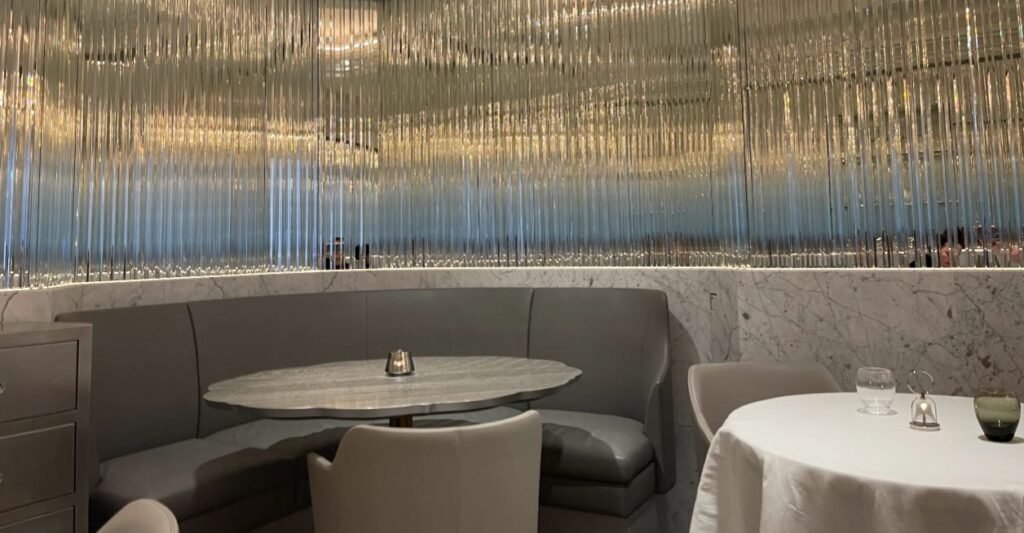
Paris’s Restaurant Kei is quiet, intimate, and meticulously detailed, but most importantly, it does a remarkable job of bringing French cuisine’s essence to life through a Japanese perspective. Situated quietly on Rue Coq Héron, it makes no grandiose announcements. Rather, it exudes assurance. Chef Kei Kobayashi’s restaurant is so captivating because of its understatement. Every dish has a backstory, and every little thing, like a delicate sugar leaf or a spoonful of roe cream, feels like a handwritten note to the diner.
The variety and complexity of upscale cuisine have significantly increased in recent years due to the emergence of foreign chefs in Paris. Kei Kobayashi, a native of Nagano, Japan, executed that jump with elegance and accuracy. He set his sights on Paris after seeing a documentary about French cooking when he was younger. The years that followed were spent developing under renowned chefs like Gilles Goujon and Alain Ducasse. These encounters molded his character in addition to honing his abilities. Through the fusion of French technique and Japanese flavor purity, he developed a style that is both inventive and emotionally impactful.
Restaurant Kei – Key Information
| Attribute | Detail |
|---|---|
| Name | Restaurant Kei |
| Chef | Kei Kobayashi |
| Location | 5 Rue Coq Héron, 75001 Paris, France |
| Cuisine | Contemporary French with Japanese influence |
| Michelin Rating | ★★★ (Three Michelin Stars) |
| Price Range | €175 to €395 depending on menu |
| Signature Dishes | Garden of Vegetables, Binchotan Langoustine, Wagyu Tartare, Blood Orange Parfait |
| Website | www.restaurant-kei.fr |
| Opened | 2011 |
| Reservation Requirement | Mandatory; high demand with limited seating |
The now-famous “Garden of Vegetables” is a notable illustration of his vision. This is by no means a typical salad; instead, it is a dish that is constructed layer by layer, with smoked salmon nestled beneath crisp seasonal greens, a whipped basil emulsion above, and black olive crumble and yogurt foam in between. Each layer reveals new character as you dig deeper. It is intellectually stimulating in addition to being visually captivating. The dish’s deliberate composition encourages you to consider flavor and structure rather than merely savor it.
Parisian haute cuisine has been under increasing pressure to move beyond glitz and glamour during the last ten years. Restaurant Kei responds to that challenge by creating dishes that are both incredibly inventive and firmly rooted in flavor. He uses binchotan charcoal to smoke his langoustine, which is served with a herbaceous glaze and sweet pepper. It appeals to a readership that values nuance over spectacle. The way that luxury ingredients are framed, presented, and harmonized is more important than just the ingredients themselves.
Kei’s menu design also exhibits consideration. He makes distinctions based on the richness of the ingredients rather than the length of the courses. The €395 Prestige menu is more decadent, with dishes like wagyu beef and several caviar pairings, while the €175 menu provides a full experience with moderation. Because of its adaptability, the restaurant is surprisingly affordable for patrons who want to celebrate without going over budget. This method seems remarkably more akin to considerate hospitality than to upscale luxury.
Special recognition should be given to Restaurant Kei’s service. The staff apologized for a previously canceled reservation by offering a complimentary glass of champagne to one of the guests upon their return after the pandemic. Another visitor described how the sommelier blind-tasting them according to their preferred flavors was a lighthearted yet very intimate touch. Even though they are inexpensive, these gestures foster a feeling of attentiveness that is frequently lacking in fine dining.
Of course, not all reviews are glowing. After a lengthy wait, one lone diner became irate after their table was inadvertently given away. Another spoke of an experience that felt too ideal, too practiced, and a lack of emotional warmth during the meal. Even so, these criticisms point to something more profound: that patrons have extremely high expectations when they arrive, which says a lot about the restaurant’s standing. The majority still depart with the impression that they have seen something extraordinary.
The significance of Restaurant Kei has only increased in the post-COVID Paris environment. Authenticity, warmth, and purpose are now more important to diners than spectacle. The compositions created by Kobayashi, who has a highly intuitive palate and deft hands, are exactly what people desire from contemporary fine dining. The focus is on using flavor and form to connect with guests rather than using tricks to impress them. Every bite feels genuine and unforced.
Kei has developed into a benchmark for successful fusion through strategic evolution. Few restaurants are able to preserve the integrity of both Asian and European styles, despite the fact that many try to combine the two. The food at Restaurant Kei harmonizes with purpose rather than fusing for novelty. A sea bass may lie next to a yuzu glaze, but the broth, which contains roasted kombu, steals the show.
Desserts are frequently described by guests as a crescendo. One in particular is aesthetically pleasing and remarkably well-balanced: the blood orange parfait with yuzu sorbet, citrus sauce, and jasmine meringue. It clings to the taste buds like a masterfully written tune. These concluding remarks—both literal and symbolic—are what help people remember Restaurant Kei.
Restaurant Kei has been able to resist the pressure to be trendy by upholding a distinct artistic vision. Neither maximalist nor minimalist, it is. It’s considerate. It’s accurate. Most importantly, it is human. The restaurant needs to continue doing what it does very well in order to attract customers; it doesn’t need any tricks.
It’s probable that Restaurant Kei will continue to shape not only the perception of fusion food but also the concept of fine dining in the years to come. Chef Kei Kobayashi’s method feels more like a guide than a fad in a time when authenticity, openness, and nuance are becoming more and more important.
